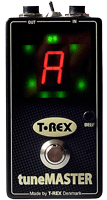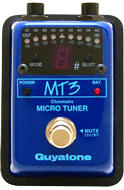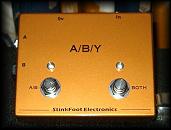One Control Minimal Series BJF Buffer

As with so many other pedals in my collection, I bought this one on a whim. I spotted it for sale on Facebook, and snapped it up, thinking it might come in handy at some later point in life – my normal guitar gear buying habit, thus 🙂
While my immediate buffer needs are covered via my trusty Korg DT-10, having this one around seemed like a good idea. I haven’t had the chance to test it out yet, to see how it stacks up against other buffer options – in my case mainly the aforementioned DT-10. But the fact that its circuit was designed by Björn Juhl leads me to suspect it will be a good one. Now I just need to find some use for it – time to build another pedalboard, perhaps? 😉
T-Rex Tunemaster

I like to place my tuner first in line, where it can sense the signal straight from the guitar. And the same goes for a good buffer, so it would make sense to have them both in the same package. But for a good while, the trend with tuners was towards true bypass, so finding a good buffered tuner was a little hard. Boss TU-2/TU-3 are obvious candidates, the Korg DT-10 is excellent but discontinued by Korg (in favour of the Pitchblack series, which are true bypass). The TC Polytune series were also true bypass, although version 3 of the Polytune and Polytune Mini adds the option of buffered bypass. So when T-Rex came out with the Tunemaster, which is selectable true or buffered bypass, I naturally wanted to try it. So far, so good. It does the job just fine, and in ”beef” (buffered) mode, there’s a small knob that lets you adjust the bypass signal level. It goes from unity gain to +10dB, and does indeed add a little ”beef” to the signal 🙂
Anything negative? Well, it can sometimes feel a tad on the slow side. The lower the pitch, the longer the time it needs to figure it out. Using the 12th fret harmonic on the lower strings really speeds things up, so it’s not a deal-breaker. A bigger worry, though, is a slight switch pop (in the other pedals) that has appeared since I introduced the Tunemaster. It goes away as soon as I turn the buffer off, and (with the buffer still on) any time I turn one pedal on between the tuner and the pedal that pops. I’ll eventually write a separate article on this subject (what switch pops are, why the actual problem is often not in the pedal that pops, and how to locate the pedal that is the root cause), but suffice to say that this points to a DC voltage leak from the Tunemaster. And yet… I haven’t been able to measure any such voltage leak from the tuner, so I don’t know what’s up with that. I need to investigate further – something my readers know can take ages for me to get around to 🙂 In any case, I put the Korg DT-10 back on the board for the time being.
Korg DT-10 tuner

Nothing fancy here at all – it’s just a good tuner pedal. I was originally going to modify it to true bypass, as I was using a TC preamp as the main buffer stage for the pedalboard. But the DT-10 turned out to be such a good buffer, that I ditched the TC and ran the signal straight through the Korg instead 🙂
It sat for years on the large pedalboard, which was then my main board, but was later moved to the new smaller board. I was intending to use the smaller Guyatone tuner on that one, but once again found I needed a good buffer at the start of the chain, and rather than fit another box on the board, I went for the DT-10. The T-Rex Tunemaster was added to the small board, so momentarily the DT-10 was benched. But now it’s back again, while I investigate a DC voltage leak from the Tunemaster.
One odd thing about the DT-10 is that it does not shut the battery off when a plug is inserted in the adapter jack… I don’t know how Korg keeps the adapter from trying to charge the battery, but there’s probably some sort of protection circuit in there. Still, this means that as soon as the adapter power is turned off, the tuner starts running on battery power instead… The pedal can of course be modified to work as normal, but I took the easy route and simply removed the battery 🙂
Guyatone MT-3 Micro Tuner

Modified to true bypass (technically it’s an A/B wiring), which was a pig of a job! I never want to do that again… There’s a quite stiff ribbon cable connecting the main input/output circuit board to the board that holds the tuner circuit and display, and of course it broke off at the solder joints… getting it put back together was really tedious. I have had a couple of requests to mod these to true bypass, but turned them down – it’s just not a job I want to do again.
As a tuner, it’s perfectly fine. And there was nothing wrong with the stock (buffered) bypass either, come to think of it. Maybe it did make the tone a tad too bright, but I honestly don’t remember (I did the true bypass mod on this one ages ago). As a tuner, it works. I probably wouldn’t recommend it for intonating guitars, but if you want a simple, small tuner, it’s just fine.
Stinkfoot true bypass loop strip
I built this one for my own pedalboard, as I wanted to be able to have lots of different effects pedals at my disposal, without having to run the signal through all of them. There are five loops in total, each functioning as a normal true bypass loop – when all loops are turned off, the signal simply passes straight through the loop strip, without touching anything but the switches. The send to the effect is also connected to ground in bypass mode, to help minimize switch pops and other nasty stuff. It is designed so you can use regular patch cables for send and return, or a TRS insert cable (tip=send, ring=return) in the return jack only. At the moment, I’m mostly using insert cables, as it makes for a less cluttered board.
Each loop also functions as a proper A/B selector (connecting the unused output to ground) if the return jack is left empty. That way, you can stick a tuner in one of the loop sends (or simply leave a loop unused) and the signal path to the amp will be muted (not just disconnected, but also shorted to ground) when you activate that loop.
The loop strip was originally built using regular 3PDT switches, and while they worked just fine, I soon got bothered by the mechanical/acoustic ”click” they made. To some extent, I think the box itself was amplifying the clicks – I have the same switches in regular pedals, where they seem less obtrusive. In this application, however, they were far too loud for quieter situations. So I have since replaced the 3PDT switches with Jack Deville true bypass relay kits, which lets me use soft-touch momentary switches instead. It’s an expensive solution, and fitting it all in the box was a right pain… But the result is smooth, quiet switching. If you’re looking into a true bypass solution where you still want to have a momentary switch (Boss pedals etc), they’re definitely worth looking into.
Oh, and before you ask – I don’t have time to build loop strips or loop boxes etc for others. Sorry 🙁
Stinkfoot true bypass loop boxes

I have a couple of single-loop true bypass boxes that can be used to insert/remove certain effects from the signal path. One is built into a Hammond 1590B-size box (same as an MXR pedal), finished in the same saffron yellow as the ABY below. That one is used for the Korg G4 leslie simulator. I simply run the signal out from the pedalboard to this box and from there to the amp. If I want to use the G4, I simply step on the loop box to insert it.
The other one is the one pictured – it’s in a smaller box, but otherwise it has the same wiring as the larger one. Getting all four jacks, plus the 9vDC jack (to power the LED) and the switch in there was a bit tricky – you need to be very careful when drilling the holes, to get them just right. But other than that, it’s just a basic true bypass loop box.
Stinkfoot ABY

I needed a transformer isolated ABY box to switch between two amps (for instance, the Twin Reverb and the Bassman/Vibratone combination), so I built one 🙂 I decided to make it an ABY instead of AB so I could choose to run both amps at the same time, should I want to. The reason to get a transformer isolated box is to stop ground loops (when combining two amps to the same signal ground source) from creating hum. Basically, it’s a box with a single input, a buffer amp stage, two switches to select A/B or both (Y). The isolation transformer is on the ”B” output, which of course also needs to be isolated from the box itself using a plastic 1/4″ jack. The colour is from the first generation Volvo C70, btw 🙂
DOD 270 A/B box

I got this one as a gift from a friend, together with the Roland Jet Phaser. I have rewired it to proper A/B wiring – the 270 does connect the unused output to ground, but through a resistor. That means the unused amp (if you’re switching amps) isn’t completely muted, so it can get noisy. I’ve mostly used it as an input selector, to quickly switch between guitars. These days, it doesn’t see much action, though.
In lieu of digging my own box out of storage to photograph it, I’ve borrowed this pic from Discofreq’s excellent Effects Database site. If you do an image search for the DOD 270, you will see a fair few different exterior designs, but mine looks just like this one.
LR. Baggs Para Acoustic D.I.

I got this one brand new in the box from Strings-n-things in Las Vegas, via eBay, and for me it was a killer deal. I spotted the auction with an hour or so left, and it stood at $100. After a quick check what the Swedish retail price was (2795 SEK – about $329 with the exchange rate as of Feb 2003), I placed a max bid of $120 or so, just to see what happened. The minimum increase at that level is $2.50, and to my surprise, the auction ended with me as the high bidder at $102.50. With shipping fees, the total cost was $117.50 – a killer deal indeed! I was fully prepared to pay the 4% duty and 25% sales tax (it would still be a great deal), but the postman rang on my door and just handed me the package… 🙂
This box has become indispensable for keeping my acoustic in check. The i-Beam system on my Furch only needs a little eq to sound good – mainly a reduction of 3 dB or so around 10-12kHz – but I have also had feedback problems, due to the large body and the guitar’s top being so responsive. It’s not always feasible to spend time getting the the monitor mix eq:d to fit my specific feedback spots, especially when playing festivals etc, so being able to do this myself – while providing the house system with a balanced XLR output, eq:d to my liking – is simply great. The ”phase” button is also useful – if the feedback situation is bad, and the notch filter can’t handle it (for instance if you have the notch set to reduce the body resonance, and the stage monitors keep getting the top to resonate as well), flick it and you’re instantly off-phase with the monitor speaker. As I sing as well as play guitar, I don’t have the option to back away from the monitors to put me off phase, but that switch does the job for me. Also, it seems to sprinkle some of that ”magic dust” on the sound – even in situations where no feedback reduction is needed, as soon as I plug into this box the acoustic suddenly sounds twice as good (and it wasn’t bad to start with…).
Furman PL-Plus E

What can be less sexy than a power conditioner? Not much, I’m sure. But still – this box has saved me from voltage spikes, weird refrigerator-turning-on noises etc for more than three decades now. The lights are broken – something in the dimmer circuit blew up about 15 years ago – but the unit still soldiers on. I originally had it in a large guitar rack (16 rack spaces full of preamps, effects etc…) but the last few years it has sat in a small rack, feeding clean power to my old amps at home. However, since I got the Eleven Rack, the Furman has seen far more use. It now lives in the rack, feeding power to the 11R rig, pedalboard and powered monitor. So once again, it gets to go with me to gigs…
